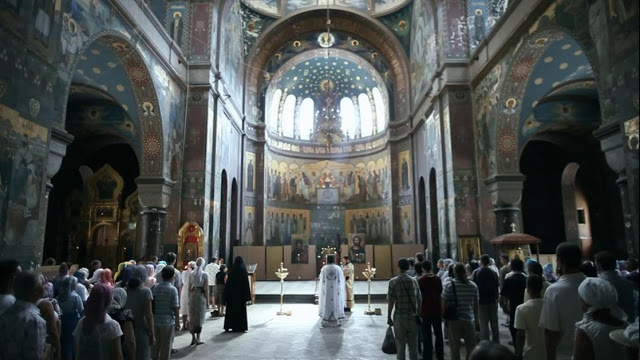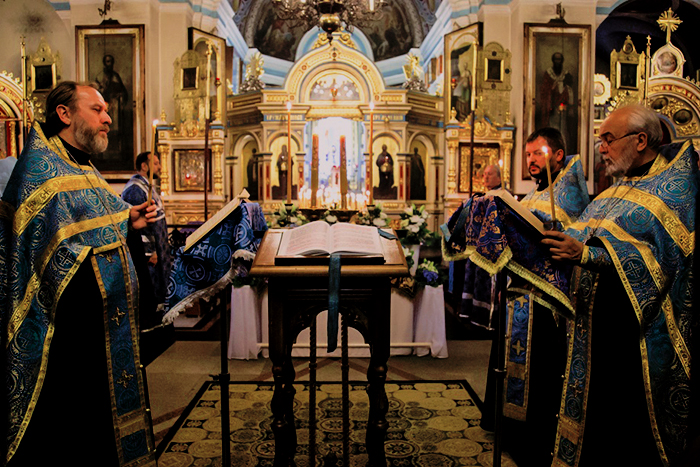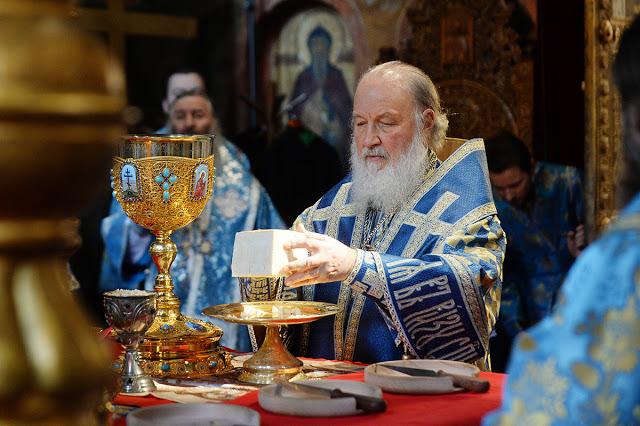 The Canon
The Canon
The miracle of the Resurrection of Jesus Christ enlightened human nature. In the canon, the portion of the Vigil which follows the reading of the Gospel, the Church shows the faithful this enlightenment. In contemporary practice, the canon consists of nine odes or songs. Each ode of the canon consists of a specific number of individual troparia.
Each individual canon has a specific subject of celebration: the Most Holy Trinity, an event from the Gospel or from the history of the Church, prayers to the Theotokos, or the magnification of a saint or saints of the day. The Sunday canons (on Saturday evening in usual Russian practice) celebrate the Resurrection of Christ and the ensuing enlightenment of the world, the victory over sin and death. Festal canons illuminate in detail the meaning of the feast and the life of the saint; as a model of the transfiguration of the world already taking place. The Church in some measure celebrates Christ’s victory over sin and death by contemplating the light of this transfiguration reflected in the canons.
The canons are read, but the initial verse of each individual ode is sung by the choir. These introductory verses are known as irmoi, from the Greek verb “to tie.” The Irmos presents a pattern for all of the troparia which follow within a given ode.

An event from the Old Testament which embodies a transfiguring, that is, a prophetic and symbolic meaning relevant to the New Testament, serves as the pattern for each introductory irmos. For example, the irmos of the first ode commemorates, in Christian terms, the Hebrews’ miraculous crossing of the Red Sea. In this irmos, the Lord is glorified as the all-powerful deliverer from evil and slavery. The irmos of the second ode is taken from the song of denunciation spoken by Moses in the Sinai desert to awaken a spirit of repentance in the Hebrews fleeing from Egypt. The second ode is sung only during Great Lent. The irmos of the third ode is based on the song of thanksgiving sung by Anna, mother of the prophet Samuel, for having been given a son. In the irmos of the fourth ode, we hear a Christian interpretation of the appearance to the prophet of the Lord God, Habakkuk; as seen in the brilliant sunlight streaming from behind the wooded mountain. In this vision, the Church perceives the glory of the coming Savior. In the fifth ode, whose theme comes from the book of the prophet Isaiah, Christ is glorified as the bringer of peace. It also contains the prophecy of the Resurrection from the dead. The sixth irmos is taken from the story of the prophet Jonah, cast into the sea and swallowed up by a whale. In the eyes of the Church, this event serves to remind the Christian that he has sunk into the abyss of sin. The irmos also expresses the idea that there is no sorrow or misfortune in which the heartfelt prayer of the faithful cannot be heard. The irmoi of the seventh and eighth odes of the canon are based on the song of the three Hebrew children who were cast into the fiery Babylonian furnace. This event is a prefiguring of Christian martyrdom. Between the eighth and ninth odes, a song in honor of the Theotokos is chanted. It begins with the words, “My soul doth magnify the Lord, and my spirit hath rejoiced in God my Savior.” It is accompanied by the refrain, “More honorable than the Cherubim, and beyond compare more glorious than the Seraphim.” The deacon chants the beginning of this glorification of the Mother of God. After censing the altar and the right side of the iconostasis, he stops before the icon of the Theotokos on the iconostasis, and, raising the censer chants: “The Theotokos and the Mother of the Light let us magnify in song.” The choir responds with the magnification of the Mother of God.
During the chanting of the magnification, the deacon censes the entire church. Then the troparia of the final ode of the canon are read, and for the last time in the Vigil, we hear the Small Litany, “Again and again, in peace let us pray to the Lord.” During the Resurrectional All-night Vigil, and following the Small Litany and the priest’s doxology, the deacon exclaims “Holy is Our God,” and this phrase is then echoed thrice by the choir.
The Exapostilarion
In monasteries which follow the order of service to the letter and in churches in which the All-night Vigil actually does last all night, sunrise coincides with this point in the service. Special hymns celebrate its approach. The first is known as the Hymn of Light, or Светилeн — Svetilen (in Russian), a term referring to the heralding of the approaching light. This type of hymn is also known by the Greek term exapostilarion, which means “I send out,” because a chanter is in fact “sent out” from the kliros to the center of the church to chant the exapostilarion. The renowned hymns “I see Thy Bridal Chamber adorned, O My Savior,” and “The Wise Thief,” heard during Passion Week, are examples of Exapostilaria/Svetilny. Among the best known of the Hymns of Light for the Mother of God is “The apostles, from the ends . . .” sung during the Dormition of the Mother of God.

After the Hymn of Light, the verse “Let every breath praise the Lord” is sung, and Psalms 148, 149, and 150 (LXX) are read. These three psalms are known as the Psalms of Praise, for in them the term “praise ye” is often repeated. Special stichera, known as the Aposticha for the praises, are combined with these psalms. They are usually sung at the close of Psalm 149 and after each verse of the short 150th Psalm. As in the case of the other stichera during the Vigil, the Aposticha for the praises glorify a Gospel event, an event in the life of the Church, or a saint or saints being commemorated on that day.
The Great Doxology
As we have already noted, in ancient times and even today in monasteries where the All-night Vigil indeed lasts all night, the sun rises during the second half of the Vigil. At this point, the Lord, the Giver of Light, is praised in a special, ancient Christian hymn, the Great Doxology, which begins with the words, “Glory to God in the highest, and on earth peace.” But before this, we see the priest through the open doors of the altar as he stands before the Holy Table and exclaims, “Glory to Thee, Who Hast shown us the light.”
In the All-night Vigil, Matins concludes with the Augmented Litany and with the Litany of Supplication, the very same Litanies which were read earlier in the Vigil, during Vespers. They are followed by the priest’s closing doxology and by the Dismissal. The priest addresses the Mother of God with the prayer: “O Most Holy Theotokos save us!” The choir responds with a glorification of the Theotokos: “More honorable than the Cherubim, and beyond compare more glorious than the Seraphim. . . .” Thereafter, the priest again glorifies the Lord Jesus Christ with the doxology “Glory to Thee O Christ God, our hope, glory to Thee.” The Choir responds with “Glory; both now and ever…” showing thereby that the glory of Christ is as well the glory of the All-holy Trinity: Father, Son and Holy Spirit. And thus ends the Vigil as it began, with a glorification of the Holy Trinity.
The Hours
After the priest’s final blessing, the First Hour and final portion of the All-night Vigil, is read.
As we have already noted, the primary idea expressed in Matins is the joyous realization by the faithful that everyone who unites themselves to Christ will be saved and will be resurrected together to be with Him. According to the Church, we can attain union with Christ only with an attitude of humility and recognition of our unworthiness. For this reason, the Vigil does not end with the festive and joyous service of Matins, but with the First Hour, a service expressing a humble, repentant striving toward God.
The daily cycle of services of the Orthodox Church includes three Hours in addition to the First Hour. The Third and Sixth Hours are read before the beginning of the Divine Liturgy, and the Ninth Hour is read before the beginning of Vespers. Technically speaking, the Hours contain selections of texts pertinent to that particular time of day. However, each Hour also has a distinct mystical and spiritual significance, for each commemorates a stage of Christ’s Passion. The services proceed with an air of serious concentration and bear the stamp of Great Lent and of the Passion. A characteristic of the Hours and one that shows their kinship to the services of Great Lent is that reading takes precedence over singing.
The subject of the Third Hour is the handing over of the Savior to be insulted and flogged. A second New Testament theme is joined to the Third Hour: the Descent of the Holy Spirit upon the Apostles. In addition, in the Third Hour we find prayers for assistance and protection in our external and internal battle with evil, and we find prayers of repentance, such as that expressed in the 50th Psalm; which begins with “Have mercy on me O God. . . .”

The Sixth Hour coincides with the hour when Christ was crucified and nailed to the Cross. During the Sixth Hour, we hear the reader express the bitterness brought on by militant evil rampant in the world; while, at the same time we hear an expression of hope in God’s help. This hope is especially strongly expressed in the third of the psalms read during the Sixth Hour, the 90th Psalm, which commences with: “He that dwelleth in the help of the Most High shall abide in the shelter of the God of heaven. . . .”
The Ninth Hour is the hour at which Christ, while on the Cross, granted paradise to the thief, and it is the time at which He gave up His soul to God the Father until His Resurrection. In the psalms of the Ninth Hour we already hear thanks being expressed to Christ for His saving of the world.
Such, in brief, is the substance of the Third, Sixth, and Ninth Hours. Now let us return to the First Hour; the hour which concludes the All-night Vigil.
Overall, in addition to commemorating the events that transpired during the first stage of Jesus Christ’s Passion, the First Hour expresses feelings of thanksgiving to God for the approaching light of day and for His setting us on a path during the coming day which is pleasing to Him. This is all expressed in the three psalms read during the First Hour, as well as, in its other prayers, and especially in the prayer, “Thou Who at all times and at every hour . . .” a prayer which is read during each of the Hours. In this prayer, the faithful ask for unity of Faith and for true knowledge of God. According to the Church, it is that knowledge that is the fountain from which will spring a Christian’s future spiritual benefits, that is, salvation and life eternal. The Lord speaks of this in the Holy Gospel according to John, chapter 17: “And this is life eternal, that they might know thee the only true God, and Jesus Christ, whom thou hast sent.” The Orthodox Church teaches that it is possible to know God only through love and oneness of mind. This is why during the Liturgy, before the confession of faith in the Symbol of Faith, we proclaim, “Let us love one another, that with one mind we may confess Father, Son, and Holy Spirit, the Trinity one in essence and undivided.”
Following the prayer, “Thou Who at all times . . .” the priest comes out of the altar. He is dressed humbly, wearing an epitrachelion but without his shining outer vestments. The temple is in semi-darkness. In such a setting, the priest concludes the First Hour, and with it the All-night Vigil, with a prayer wherein he glorifies Christ as the True Light, Who enlighteneth and sanctifieth every man that cometh into the world. Turning to the Icon of the Mother of God, he commemorates her at the conclusion of the prayer. The choir responds with a festive hymn taken from the Akathist for the Annunciation of the Theotokos, “To thee the Champion Leader. . . .”
Translated by priest Peter Perekrestov
Edited by Lawrence Miller
From the Introductory chapter, “The History of Church Rubrics”
of The Explanatory Typicon by Prof. Michael Skaballanovitch
of the Kiev Theological Academy, 1910




